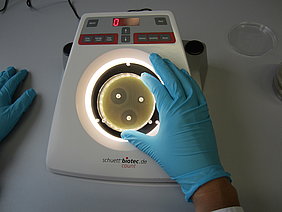Antibiotic resistances are widespread in surface waters, but do not currently pose a threat to drinking water. Against the background of resource protection and the high communication relevance of the topic, the state of knowledge was deepened with regard to the current contamination of raw water, the temporal development and the elimination during treatment.
The spread of antibiotic resistance in the aquatic environment has been described in a large number of studies worldwide. For this reason, antibiotic resistance is increasingly coming into focus as a new parameter for assessing hygienic water quality. Therefore, reliable methods for the detection of antibiotic resistance are essential.
Within the scope of the project, the detection methodology for antibiotic resistance was further developed. A culture method for the detection of cephalosporine-resistant and carbapenemase-producing oligotrophic bacteria was successfully established. The methodology for the detection of antibiotic resistance genes was also further developed with regard to the detection of complete genes (long amplicon qPCR). By using this PCR methodology, reduction by reactive processes in drinking water treatment can be measured more reliable.
With the further developed innovative microbiological and molecular biological methods, it was possible to expand the data basis with regard to the occurrence of antibiotic resistances in raw water and their behaviour during drinking water treatment. The results of the project confirm that there is currently no risk to drinking water. For the recording of the current status and the temporal developments as well as for a secured evaluation of the situation, the future implementation of monitoring programs with the established methods is recommended.
Publications
Stelmaszyk, L.; Stange, C.; Sidhu, J.; Tiehm, A.: Detection of β-lactamase producing oligotrophic (environmental) bacteria in German surface waters with adapted culturing methods and subsequent Micronaut-S assay. In: EDAR 2022 – 6th International Symposium on the Environmental Dimension of Antibiotic Resistance, Gothenburg, Sweden, 22.-27.09.2022, Book of abstracts: 1 page (2022)
Stange C., Tiehm A.: Verhalten von Antibiotika-Resistenzgenen bei der Trinkwasseraufbereitung. Veröffentlichungen aus dem Technologiezentrum Wasser, ISSN 1434-5765, TZW-Band 76 (2017)
Stange C.,Sidhu J.P.S.,Tiehm A.,Toze S.: Antibiotic resistance and virulence genes in coliform water isolates. International Journal of Hygiene and Environmental Health 219: 823-831 (2016) DOI 10.1016/j.ijheh.2016.07.015
Stoll C., Sidhu J.P.S., Tiehm A., Toze S.: Prevalence of clinically relevant antibiotic resistance genes in surface water samples collected from Germany and Australia. Environmental Science & Technology 46: 9716-9726 (2012) DOI.org/10.1021/es302020s
Stange C., Sidhu J.P.S., Toze S., Tiehm A.: Comparative removal of antibiotic resistance genes during chlorination, ozonation, and UV treatment. Int. J. Hyg. Environ. Health 222: 541-548 (2019) DOI 10.1016/j.ijhe.2019.02.002
Stange C., Yin D., Xu T., Guo X., Schäfer C., Tiehm A.: Distribution of clinically relevant antibiotic resistance genes in Lake Tai, China. Science of the Total Environment 655: 337-346 (2019) DOI 10.1016/j.scitotenv.2018.11.211
The volumes of the TZW publications can be ordered here.

![[Translate to English:] Prüfstelle-Produktprüfung_Teststand Test centre and product testing](/fileadmin/_processed_/0/9/csm_TZW-Karlsruhe_Pruefung_Geraete-Teststand_377188946c.jpg)
























